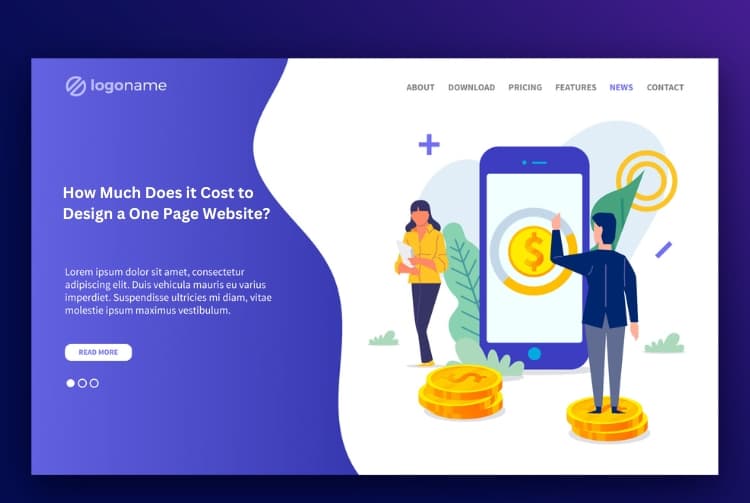How Much Does it Cost to Design a One Page Website?

Introduction
Designing a one-page website requires a thoughtful and strategic approach to encapsulate all essential information, engaging visuals, and necessary functionalities within a single, cohesive layout. The design process begins by conceptualizing a clear hierarchy of content, ensuring impactful messaging and intuitive navigation. A visually appealing yet minimalistic layout is crafted, employing strategic use of whitespace, compelling visuals, and concise text to maintain user focus and guide seamless navigation. Each section of the website, carefully organized and visually distinct, flows smoothly into the next, utilizing intuitive scrolling or anchor links for effortless user exploration.
Engaging elements, such as interactive animations or subtle transitions, add depth and interactivity without overwhelming the user experience. With a strong emphasis on responsiveness, the design ensures seamless adaptability across various devices, optimizing user engagement. Clear calls-to-action strategically placed throughout the page prompt users to take desired actions, be it contacting, exploring more content, or making a purchase. Ultimately, the one-page website design harmonizes visual appeal, functionality, and user experience to deliver a cohesive and impactful digital presence.
Factors Affecting the One-Page Website Development Cost in India:
Here are the factors affecting website development cost in India given below:
1. Design Complexity:
The intricacy of the design significantly influences the cost of a one-page website. Custom graphics, intricate animations, parallax scrolling effects, and unique layouts require specialized design skills and more time for implementation. A more intricate and visually stunning design will likely incur higher expenses due to the increased complexity and effort involved in its creation.
2. Functionality and Features:
The inclusion of additional functionalities and features can impact the cost of a one-page website. If the site requires contact forms, image galleries, interactive elements, multimedia integration, or any other specific functionalities beyond basic content display, it will contribute to increased costs. Implementing these features demands additional development time and expertise.
3. Responsive Design:
Ensuring that the website is responsive and performs well across various devices and screen sizes is essential. Responsive design requires additional design considerations, layout adjustments, and testing efforts to ensure a seamless user experience on desktops, laptops, tablets, and smartphones. This meticulous optimization might add to the overall cost.
4. Content Creation:
The cost may rise if the designer is tasked with creating or sourcing content for the one-page website. Content creation includes writing text, sourcing high-quality images, creating graphics, or producing videos that align with the website's theme and purpose. Depending on the extent of content creation required, this can affect the overall project cost.
5. Designer's Expertise:
The level of expertise and experience of the designer or design agency plays a significant role in determining the cost. Experienced designers or agencies with a strong portfolio and a track record of delivering high-quality work may charge higher rates due to their specialized skills, reputation, and the value they offer in terms of design quality and expertise.
6. Geographical Location:
The geographical location of the designer or agency can influence pricing. Rates may vary in different regions or countries due to differences in living costs, market demand, and local economic factors. Designers in certain regions where the cost of living is lower may offer more competitive rates compared to those in regions with higher living expenses.
An One-Page Website's Estimated Cost Range is as Follows:
1. Basic One-Page Website:
A simple one-page website with minimal design elements and standard functionalities might cost between $300 to $1000 or more, depending on the factors mentioned above.
2. Moderately Complex One-Page Website:
A one-page website with moderate design complexity, additional features like forms or galleries, and responsive design could range from $1000 to $3000.
3. Highly Customized One-Page Website:
For a highly customized design with intricate graphics, animations, unique functionalities, and responsive design across various devices, the cost could go beyond $3000, potentially reaching $5000 or more.
Keep in mind that these estimates are indicative and can vary based on the designer's or agency's rates, the scope of the project, the level of customization, additional services (such as content creation or SEO), and the specific requirements of the one-page website.
Always communicate your needs clearly with the designer or agency to get an accurate quote. Consider factors like design complexity, functionality requirements, responsiveness across devices, and any additional services required for a comprehensive quote. Additionally, ensure that the chosen designer or agency aligns with your vision and has a portfolio that reflects their expertise in one-page website design.
Frequently Asked Questions (FAQ):
Q. How can a minimalist approach benefit a one-page website's design and functionality?
A. A minimalist approach in designing a one-page website offers numerous benefits in both design and functionality. By embracing simplicity, a minimalist design streamlines content presentation, fostering clarity and focus. This approach ensures that essential information stands out prominently while eliminating distractions, enhancing readability, and guiding seamless navigation. Furthermore, a minimalist layout facilitates faster loading times, elevating user experience by providing quick access to critical content. This design philosophy emphasizes a clean, uncluttered aesthetic, enabling impactful storytelling and effective communication of the website's message.
Q. What are the key design elements crucial for an impactful one-page website?
A. Several key design elements are pivotal for crafting an impactful one-page website. Clear and compelling messaging communicated through concise yet engaging copywriting captivates visitors' attention. Intuitive navigation, whether through fixed menus or anchor links, ensures smooth user flow across sections. Visually appealing layouts, complemented by high-quality imagery and balanced use of whitespace, create a harmonious visual hierarchy. Interactive elements, like animations or subtle transitions, contribute to engagement without overwhelming users. Responsive design is crucial, ensuring seamless adaptability to various devices, enhancing accessibility and user satisfaction.
Q. In what ways does responsive design influence the cost and development of a one-page website?
A. Responsive design significantly influences the cost and development of a one-page website due to the additional design considerations and testing efforts involved. Optimizing the website for different screen sizes and devices demands meticulous planning, adjustments in layout, and rigorous testing to ensure consistent functionality and visual appeal across diverse platforms. This comprehensive approach to responsiveness adds complexity to the development process, potentially increasing costs.
Q. What role does user experience (UX) play in the design and success of a one-page website?
A. User experience (UX) stands as a cornerstone for the design and success of a one-page website. It dictates how visitors interact with and perceive the site, impacting engagement and conversion rates. A well-crafted UX design ensures intuitive navigation, ease of information access, and a pleasant browsing journey. User-centric design principles guide the layout, functionality, and accessibility of the website, focusing on delivering a satisfying and meaningful experience to visitors.
Q. How can a one-page website effectively communicate its message and call-to-action (CTA) within a single page?
A. Effectively communicating a message and call-to-action (CTA) within a single page necessitates strategic placement and concise presentation. Clear and concise content, coupled with compelling visuals, guides users' attention towards the central message and prompts action. Thoughtfully positioned CTAs, distinguished by contrasting colors or positioning, prompt users to take desired actions, be it making a purchase, contacting, or exploring more content. This strategic placement within a single page optimizes user engagement and conversion rates by directing user actions effectively.
Read also:
CRM Software for Financial Advisory Firms
Enhance your Business Dynamics by Hiring Dynamic Web Design Services
E-commerce Website Design Tips that Help you Increase Online Sales
eCommerce Website Development Services to turn your browsers into Buyers
How to Reduce Load Time of a Dynamic Website?
Why is a Dynamic Website Good?
What is the Development Cost of a Dynamic Website in India?
Recent Blogs

What is the Role of Ecommerce Website Design Company?

Coding Skills For SEO: 10 Ways Coding Skills Can Improve SEO Efforts
